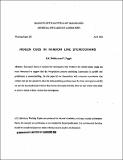| dc.contributor.author | Nishihara, H. K. | |
| dc.contributor.author | Poggio, T. | |
| dc.date.accessioned | 2008-04-15T13:51:09Z | |
| dc.date.available | 2008-04-15T13:51:09Z | |
| dc.date.issued | 1982-04 | |
| dc.identifier.uri | http://hdl.handle.net/1721.1/41174 | |
| dc.description.abstract | Successful fusion of random-line stereograms with breaks in the vernier acuity range has been interpreted to suggest that the interpolation process underlying hyperacuity is parallel and preliminary to stereomatching. In this paper (a) we demonstrate with computer experiments that vernier cues are not needed to solve the stereomatching problem posed by these stereograms and (b) we provide psychophysical evidence that human stereopsis probably does not use vernier cues alone to achieve fusion of these random-line stereograms. | en |
| dc.description.sponsorship | MIT Artificial Intelligence Laboratory | en |
| dc.language.iso | en_US | en |
| dc.publisher | MIT Artificial Intelligence Laboratory | en |
| dc.relation.ispartofseries | MIT Artificial Intelligence Laboratory Working Papers, WP-230 | en |
| dc.title | Hidden Cues in Random Line Stereograms | en |
| dc.type | Working Paper | en |
